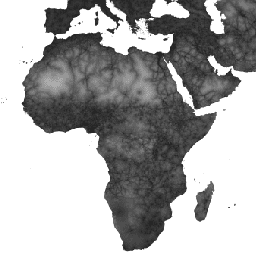
- Dostępność zbioru danych
- 2019-01-01T00:00:00Z–2020-01-01T00:00:00Z
- Dostawca zbioru danych
- Malaria Atlas Project
- Tagi
Opis
Ta mapa globalnej dostępności przedstawia czas dojazdu lądowego (w minutach) do najbliższego szpitala lub kliniki we wszystkich obszarach między 85 stopniem szerokości geograficznej północnej a 60 stopniem szerokości geograficznej południowej w nominalnym roku 2019. Obejmuje też czas podróży „pieszej”, w której wykorzystywane są wyłącznie niemotorowe środki transportu.
Dzięki dużym wysiłkom w zakresie zbierania danych podejmowanym przez OpenStreetMap, Mapy Google i badaczy akademickich udało się zebrać najbardziej kompletną kolekcję lokalizacji placówek opieki zdrowotnej. Ta mapa powstała w wyniku współpracy MAP (University of Oxford), Telethon Kids Institute (Perth, Australia), Google i University of Twente (Holandia).
Projekt ten opiera się na wcześniejszych pracach opublikowanych przez Weissa i in. w 2018 r. (doi:10.1038/nature25181). Weiss i współautorzy (2018 r.) wykorzystali zbiory danych dotyczące dróg (obejmujące pierwsze w historii użycie na skalę globalną zbiorów danych Open Street Map i Google Roads), kolei, rzek, jezior, oceanów, warunków topograficznych (nachylenia i wysokości), rodzajów pokrycia terenu i granic państw. Każdemu z tych zbiorów danych przypisano prędkość lub prędkości podróży w postaci czasu potrzebnego na pokonanie każdego piksela danego typu. Zestawy danych zostały następnie połączone, aby utworzyć „powierzchnię tarcia”, czyli mapę, na której każdy piksel ma przypisaną nominalną ogólną prędkość podróży na podstawie typów występujących w tym pikselu. W przypadku bieżącego projektu utworzono zaktualizowaną powierzchnię o wysokim współczynniku tarcia, aby uwzględnić najnowsze ulepszenia w danych o drogach w OSM.
Algorytmy najkrótszej ścieżki (uruchamiane w Google Earth Engine, a w przypadku obszarów o wysokiej szerokości geograficznej – w R) zostały użyte w połączeniu z tą powierzchnią tarcia do obliczenia czasu podróży ze wszystkich lokalizacji do najbliższego (w czasie) ośrodka opieki zdrowotnej. Zbiór danych o placówkach opieki zdrowotnej wykorzystuje dane o lokalizacji z 2 największych globalnych baz danych: (1) dane OSM, które zostały zebrane i udostępnione do pobrania na stronie www.healthsites.io; oraz (2) dane wyodrębnione z Map Google. Globalne zbiory danych zostały uzupełnione o lokalizacje obiektów na skalę kontynentalną, które zostały niedawno opublikowane w przypadku Afryki i Australii. Aby ułatwić porównywanie źródeł danych, użyto tylko placówek zdefiniowanych jako szpitale i kliniki. Wiele punktów znalezionych w tym samym pikselu zostało połączonych, aby dopasować je do rozdzielczości analizy określonej przez wybraną siatkę reprezentującą powierzchnię Ziemi. Każdy piksel na mapie dostępności przedstawia najkrótszy czas (w minutach) potrzebny na dotarcie z danego miejsca do szpitala lub kliniki.
Kredyty za zbiór danych źródłowych są opisane w odpowiednim dokumencie.
Pasma
Rozmiar piksela
927,67 m
Pasma
| Nazwa | Jednostki | Minimum | Maks. | Rozmiar piksela | Opis |
|---|---|---|---|---|---|
accessibility |
min | 0 | 41504.1 | metry | Czas dojazdu do najbliższego szpitala lub przychodni. |
accessibility_walking_only |
min | 0 | 138893 | metry | Czas dojazdu do najbliższego szpitala lub przychodni środkiem transportu niemotorowego. |
Warunki korzystania z usługi
Warunki korzystania z usługi
Ta praca jest na międzynarodowej licencji Creative Commons Attribution 4.0.
Cytaty
D.J. Weiss, A. Nelson, C.A. Vargas-Ruiz, K. Gligorić, S. Bavadekar, E. Gabrilovich, A. Bertozzi-Villa, J. Rozier, H.S. Gibson, T. Shekel, C. Kamath, A. Lieber, K. Schulman, Y. Shao, V. Qarkaxhija, A.K. Nandi, S.H. Keddie, S. Rumisha, E. Cameron, K.E. Battle, S. Bhatt, P.W. Gething. Globalne mapy czasu dojazdu do placówek opieki zdrowotnej. Nature Medicine (2020).
Odkrywanie za pomocą Earth Engine
Edytor kodu (JavaScript)
var dataset = ee.Image('Oxford/MAP/accessibility_to_healthcare_2019'); var accessibility = dataset.select('accessibility'); var accessibilityVis = { min: 0.0, max: 41556.0, gamma: 4.0, }; Map.setCenter(18.98, 6.66, 2); Map.addLayer(accessibility, accessibilityVis, 'Accessibility');
